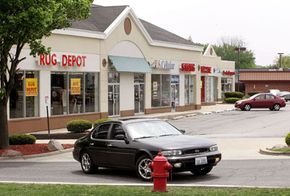Curbing the Effects of Sprawl
While there is no one easy solution to urban sprawl, there are numerous ideas out there as to how it can be contained or planned more efficiently, at the very least. According to those opposed to sprawl, it's often fueled by poor planning by regional and local governments. A measure called smart growth advocates reducing sprawl by fixing up run-down urban communities, building new and better communities closer to cities, and preserving open space before it's developed.
The Sierra Club proposes a number of ideas to counter sprawl, including investing in environmentally friendly public transportation as well as providing other transportation options, like walking and cycling. The group also encourages local and regional planning committees to consider transportation needs, environmental concerns and land-use goals when planning for the future. One of the main concerns of families is affordable housing, which the Sierra Club insists must be provided in close proximity to jobs and public transit. Also, the group recommends that developers be charged for the costs of public services required by sprawl, such as water and sewer lines, new roads and public schools.
Advertisement
Many states have already adopted sprawl-related countermeasures. For example, Tennessee now requires all municipalities to identify urban growth boundaries [source: USA Today]. Other states are even using tax incentives to encourage wealthy rural landowners to donate land to conservationist organizations or to the state in which it's located. Experts agree that individuals need to take a vested interest on a large scale when it comes to curbing the negative effects associated with sprawl. For example, commuters should carpool or use public transit to reduce tailpipe emissions that contribute to air pollution.
No matter how you feel about urban sprawl, it is an issue that warrants a closer examination by the powers-that-be. Are white picket fences an adequate trade-off for the displacement of wildlife? It's doubtful that anyone will ever agree. Hopefully, a realistic and attainable middle ground can be identified and reached in time.
Related HowStuffWorks Articles
More Great Links
- Sprawl City
- "A comprehensive look at sprawl in America"
- Sprawl Watch
- National Center for Policy Analysis
Sources
- American Forests. "Urban Sprawl Information."http://www.americanforests.org/resources/sprawl/
- Barry, Patrick L. "Urban Sprawl: The Big Picture." NASA. 11 Oct 2002. http://science.nasa.gov/headlines/y2002/11oct_sprawl.htm
- David Suzuki Foundation. 2003.http://www.davidsuzuki.org/Publications/Driven_to_Action.asp
- Dries, Mike. "Undoing Urban Sprawl." Milwaukee Business Journal. 14 Feb 1997. http://milwaukee.bizjournals.com/milwaukee/stories/1997/02/17/story3.html
- El Nasser, Haya and Paul Overberg. "A Comprehensive Look at Sprawl in America." USA Today. 22 Feb 2001. http://www.usatoday.com/news/sprawl/main.htm
- Environmental Literacy Council. "Urban Sprawl." April 2, 2008.http://www.enviroliteracy.org/article.php/409.html
- European Environment Agency. "Urban Sprawl in Europe: The Ignored Challenge." EEA Report. 2006. http://reports.eea.europa.eu/eea_report_2006_10/en/eea_report_10_2006.pdf
- Frumkin, Howard M.D., DRPH. "Urban Sprawl and Public Health." Public Health Reports. May-June 2002. http://www.cdc.gov/healthyplaces/articles/Urban%20Sprawl%20and%20Public%20Health%20-%20PHR.pdf
- Glaeser, Edward and Matthew Kahn. "Sprawl and Urban Growth." National Bureau of Economic Research. May 2003. http://papers.nber.org/papers/w9733.pdf
- James, Barry. "The Future of Cities: Learning to Manage Urban Sprawl." International Herald Tribune. 12 August 2002. http://www.iht.com/articles/2002/08/12/cities_ed3_.php
- Kammer, Jerry. "Immigration Fueling Huge Population Jump, Study Warns." SignOnSandiego.com. 30 Aug 2007. http://signonsandiego.printthis.clickability.com/pt/cpt?action=cpt&title=SignOnSanDiego.com+%3E+News+%3E+Nation+--+Immigration+fueling+huge+population+jump%2C+study+warns&expire=&urlID=23709133&fb=Y&url=http%3A%2F%2Fwww.signonsandiego.com%2Fnews%2Fnation%2F20070830-1525-cnsimmig.html&partnerID=621
- "Lighting Up the Ecosphere." NASA Science News. 15 Nov 2000. http://science.nasa.gov/headlines/y2000/ast15nov_1.htm
- Meadows, Donella H. "Stop Sprawl: Better Not Bigger." The Global Citizen. 4 March 1999. http://www.sierraclub.org/sprawl/articles/meadows2.asp
- Mitchell, John G. "The American Dream: Urban Sprawl." National Geographic Magazine Online. August 2008. http://ngm.nationalgeographic.com/ngm/data/2001/07/01/html/ft_20010701.3.html
- National Center for Policy Analysis. "The Truth about Urban Sprawl." March 24, 1999.http://www.ncpa.org/ba/ba287.html
- Numbers USA. "Urban Sprawl."http://www.numbersusa.com/interests/urbansprawl.html
- Orsman, Bernard. "Call to Put Council Shares Into Trust." The New Zealand Herald. June 23, 2008. http://www.nzherald.co.nz/section/1/story.cfm?c_id=1&objectid=10517744
- Roberts, Sam. "In Shift, 40% of Immigrants Move Directly to Suburbs." The New York Times. Oct. 17, 2007. http://www.nytimes.com/2007/10/17/us/17census.html?_r=1&_r&oref=slogin
- Sierra Club. "Stopping Sprawl."http://www.sierraclub.org/sprawl/
- Sprawl City. 2007.http://www.sprawlcity.org/
- "Sprawl puts Florida's future at risk." Tampa Bay Times. Dec. 27, 2006. http://www.sptimes.com/2006/12/27/news_pf/Opinion/Sprawl_puts_Florida_s.shtml
- "Sydney Struggles with Growing Pains." China Daily. Dec. 12, 2006. http://english.peopledaily.com.cn/200612/12/eng20061212_331400.html
- U.S. Department of Justice. "Urban, Suburban, and Rural Victimization, 1993-98." Oct. 18, 2000.http://www.ojp.usdoj.gov/bjs/abstract/usrv98.htm
